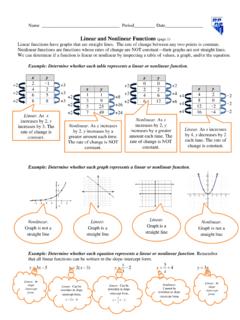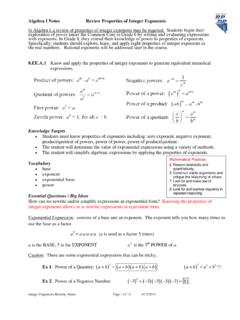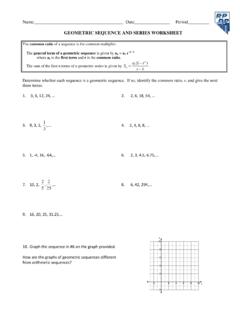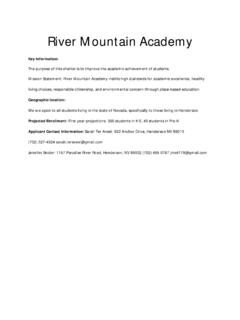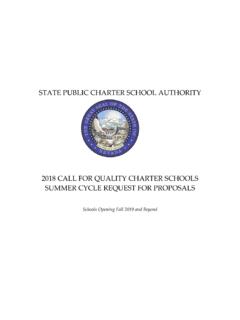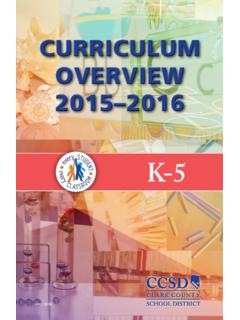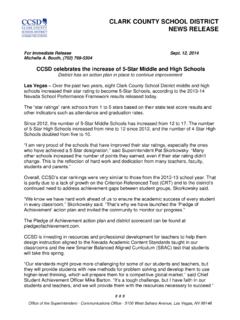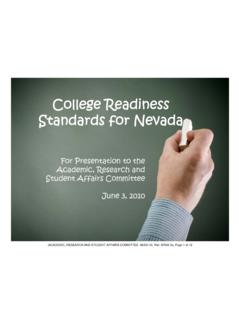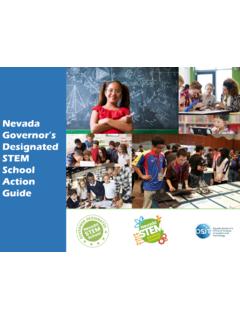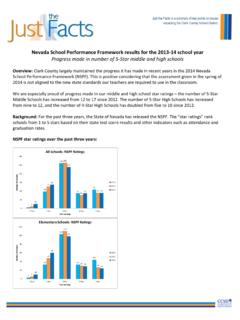Transcription of Nevada Academic Content Standards - Resource Page
1 NACS English Language Arts November 2013 Page 1 of 3 Nevada Academic Content Standards - Resource Page The resources below have been created to assist teachers' understanding and to aid instruction of this standard. College and Career Readiness (CCR) Anchor Standar d Standar d: - Determine the meaning of words and phrases as they are used in a text, disting uishing literal from nonliteral lang uage. Interpret words and phrases as they are used in a text, inc luding de termining technical, connotative, and figur ative meanings, and ana lyze how specific wor d choices shape meaning or tone.
2 Questions to Foc us Learning Why do authors use different langua ge in different texts? Why must readers be able to disting uish between different type s of langua ge? Authors use wor ds in different ways to convey shade s of meaning. A reader must make meaning of different type s of language in various ways to understand the nua nces of an author's message . Student Friendly Objective s Knowledge Targets I know literal l anguage is words or phrases that express the ir most common meaning. I know nonliteral langua ge is words or phrases that have to be interpreted by the reader because their meaning is not explicitly stated.
3 I know a phrase is a group of wor ds that have meaning. I know context clues are the wor ds or phrases surrounding an unknown word that can provide hints about the meaning of the word. Reasoning Targets I can figur e out the meaning of literal words and phrases within a text. I can figur e out the meaning of nonliteral words and phrases within a text. I can distinguish between literal and nonliteral langua ge . I can use context clues to figur e out the meaning of wor ds and phrases within a text. I can use prior knowledge to determine the meani ng of words and phrases within a text.
4 NACS English Language Arts November 2013 Page 2 of 3 Vocabulary context clues explicit literal lang uage nonliteral lang uage phrase pr ior knowledge Teacher Tips Literal and Nonliteral Translations of Idioms - In this lesson plan, students explore figur ative langua ge through read- alouds, teache r modeling, and student -centered activities and primaril y focus on the contrast be tween literal and nonliteral translations of idioms. Students also research the origins of selected idioms and discuss how idioms are related to personal expe riences. The lesson includes a link to an online interactive tool where students view literal representations of idioms, determine their metaphor ical meaning, a nd then use the idiom in a sentence.
5 (Source: Read Write Think, International Reading Association, NCTE) Similes, Metaphors, and Personification - This lesson plan is for use with students after they have a working knowledge of figurative lang uage, specifi cally similes, metaphors, and personification. Students learn to ide ntify examples of figur ative lang ua ge and demonstrate mastery through use of the de vices in the ir own writing. The lesson pr ovides a list of books that demonstrate use of similes, metaphors, and pe rsonification, and also a list of songs that can be used to teach figurative de vices.
6 (Source: Read Write Think, International Reading Association, NCTE) Strategies for Literal and Nonliteral Vocabulary - This article gives an overview of effective strategies for vocabulary instruction and some model lessons for de veloping word consciousness (using animal i dioms), wor d-meaning recall, and contextual ana lysis. Most str ategies are appropr iate for third grade and deal with literal or figur ative meanings of words in text. Wor d Consciousness - The Vocabulary-Rich Classroom: Modeling Sophisticated Word Use to Promote Word Consciousness and Vocabulary Growth pr ovides information for teaching vocabulary and an explana tion of what knowing a word really means.
7 The article also provides teaching str ategies to support children s growth in knowing words. NACS English Language Arts November 2013 Page 3 of 3 Vertical Prog ression - Ask and answer questions about unknown words in a text. - Identify words and phrases in stories or poe ms tha t suggest feelings or appeal t o the sens es. - Describe how wor ds and phrases ( , regular beats, alliteration, rhymes, repe ated lines) supply rhythm and meaning in a story, poem, or song. - Determine the meaning of wor ds and phrases as they are us ed in a text, inc luding those that allude to significant cha racters found in mythology ( , Herculean).
8 - Determine the meaning of wor ds and phrases as they are us ed in a text, inc luding figurative langua ge such as metaphors and similes. - Determine the meaning of wor ds and phrases as they are us ed in a text, inc luding figurative and connotative meanings; analyze the impact of a specific word choice on meaning and tone . - Determine the meaning of wor ds and phrases as they are us ed in a text, inc luding figurative and connotative meanings; analyze the impact of rhymes and other repe titions of sounds ( , alliteration) on a specific verse or stanza of a poem or section of a story or dr ama.
9 - Determine the meaning of wor ds and phrases as they are us ed in a text, inc luding figurative and connotative meanings; analyze the impact of specific wor d choices on meaning and tone, including analogies or allusions to other texts. - Determine the meaning of words and phrases as they are used in the text, inc luding figur ative and connotative meanings; analyze the cumulative impact of specific wor d choices on meaning and tone ( , how the language evokes a sense of time and place; how it sets a for mal or informal tone). - Determine the meaning of words and phrases as they are used in the text, inc luding figurative and connotative meanings; analyze the impact of specific word choices on meaning and tone, including words with multiple meanings or langua ge that is particularly fresh, enga ging, or beautiful (Inc lude Shakespeare as well a s other authors).
10 The above information and more can be accessed for free on the Wiki-Teacher website. Direct l ink for this standard.





